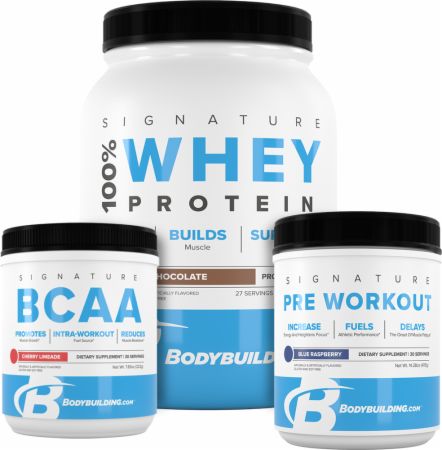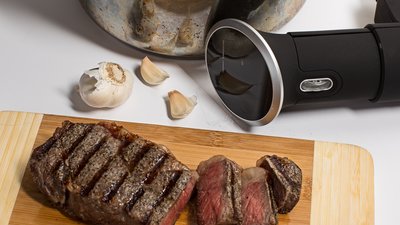I was sitting in a pub with my friend Dan the other day when my phone alarm went off. Dan asked if I had a hot date to get to. Alas, no, I said. It was just a reminder that my chicken had been cooking for an hour.
"Don't you think you should go home and take it out of the oven," he said.
"No problem," I replied. "I'm cooking it sous vide."
As long as I got home in the next hour or so, I assured Dan, the chicken would not only be fine, it would be great—the moistest he'd ever taste. If you eat a lot of poultry—or beef, fish, or pork—and you've had your share of dry, stringy, tasteless dishes, you need to start cooking sous vide, too.
What Is Sous Vide Cooking?
Sous vide, French for "under vacuum," is a way to cook food that has been around in one form or other since the 18th century. Only in the 1970s and 1980s, with the improvements in plastics, did it become a preferred prep method at some of the most highly ranked restaurants. From there, its popularity spread to caterers, hotels, companies who prepare airline food, and now to home kitchens.
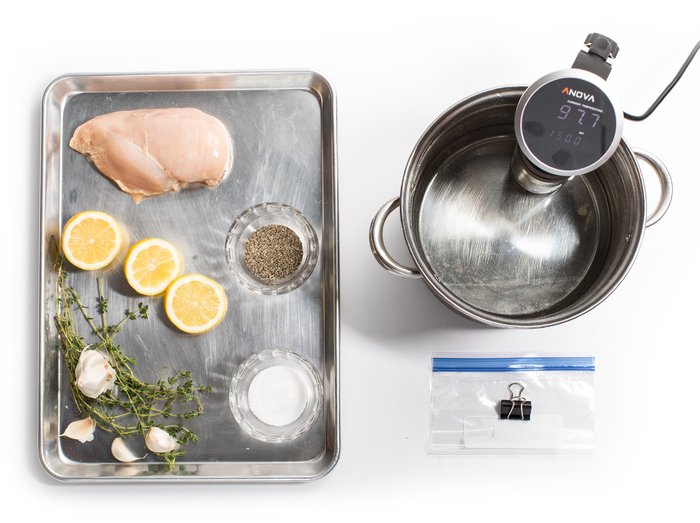
Sous vide is a simple way to cook to perfection everything from meats and vegetables to custards and cakes. And you don't need to worry about using some fancy machine to create a vacuum: The little amount of vacuum you need you can create by hand.
How Do You Cook Sous Vide?
You need a sous vide cooker, a pot full of water, a zip-close bag, and a binder clip. You'll also need access to electricity and a watch.
To cook a chicken breast, fill up a pot with water, clamp the sous vide cooker to the pot, and set the temperature on the cooker to heat the water to 150 degrees F.
Next, salt and pepper the breast, add any additional seasoning or herbs you'd like, then put it all in the zip-close bag. You want the chicken to be submerged in the water, so squeeze as much air out of the bag as you can before closing it. As soon as the sous vide cooker displays the desired temperature, put the bag in the pot, attaching it to the edge of the pot with the binder clip. Make sure the chicken is fully submerged.
If part of the meat is sticking out above the water line, get more air out of the bag. Either open a corner of the bag and squeeze a little more air out, or insert a straw and suck out a little air. Once the chicken is fully submerged, take note of the time or start a timer, and just walk away.
Within about an hour (two hours if the chicken is frozen), the chicken will be a uniform 150 degrees F, wonderfully moist, and full of flavor. It will be so tender you can cut it with a fork, and flavored with whatever herbs and seasonings you added to the bag. If it isn't done to your taste, put it back into the 150-degree water for another 10-15 minutes.
If you want to cook New York strip steak, set the device for 129 degrees and leave the meat in for an hour. I will usually just salt and pepper the meat so all the taste comes through. You can then "finish" the steak, or any other meat, by quickly browning it in a pan with a bit of oil or butter. This is for appearance only; the meat will be perfectly cooked without browning.
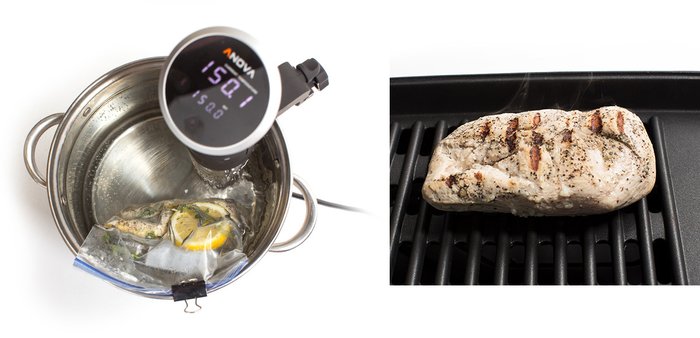
To prepare salmon, sprinkle it with some coarse salt, add fresh or dried dill and lemon juice, put it in the bag, and cook at 115 degrees for 45 minutes. Leave the skin on so the fish is easier to handle once you remove it from the bag. The skin will slide right off when you're ready to put the salmon on a plate.
Sous vide cooking works well for barbecue ribs, too. Just dry rub them or slather them with barbecue sauce, put them in big bag, and cook them for 12 hours in water heated to 165 degrees F. Periodically add water to the pot to keep the ribs submerged. The meat will be fall-off-the-bone tender when finished.
For perfect glazed carrots, put carrots, butter, sugar, and salt in the bag and cook for an hour at 183 degrees F. You can use this combination of temp and time for all vegetables, in fact.
Can You Overcook Foods with Sous Vide?
It's difficult to overcook with sous vide. In the oven or on the grill, food cooks quickly at a very high temperature. Left untended, the food can get as hot as the heat source and be destroyed. With sous vide, the food can't get any hotter than the water it's in, and the water never gets any hotter than what you set the sous vide device for.
The only thing to watch out for is leaving the food in the water way too long. Cook a piece of steak or chicken for, say, 6 hours, and it's going to have a mushy texture. But, you can cook if for 2-3 hours and it will still be perfect. Try doing that on a grill!
Are Meats Cooked with Sous Vide Safe to Eat?
You may have heard somewhere that food bacteria thrive between 40-140 degrees F, or that you must cook chicken until its internal temperature reaches 165 degrees F and pork until it reaches 160 degrees F. This is all true, but safe food preparation depends on the right combination of time and temperature.
Once the internal temperature of the chicken reaches:
- 136 degrees F, cook it for 68.4 minutes
- 140 degrees F, cook it for 27.5 minutes
- 145 degrees F, cook it for 9.2 minutes
- 150 degrees F, cook it for 2.8 minutes
- 155 degrees F, cook it for 47.7 seconds
- 160 degrees F, cook it for 14.8 seconds
- 165 degrees F, the chicken is safe to eat immediately
As soon as the internal temperature of chicken reaches 165 degrees F, all the bacteria are, indeed, killed. But you can also kill the bacteria by cooking the chicken until its internal temperature stays at 136 degrees F for a certain amount of time. As you can see from the chart, once the internal temperature reaches 150 degrees, the temperature used for sous vide chicken, all the bacteria are dead within 2.8 minutes. The rest of the cooking time is designed to give the meat the right consistency.
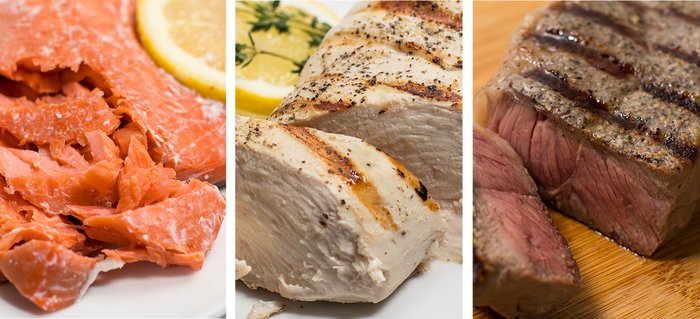
Times and temperatures vary, but the bottom line is that sous vide combines lower cooking temperatures with longer cooking times to make the food completely safe to eat, whether it's beef, pork, poultry, or fish.
One concern I had was the idea of using a plastic bag to cook meat. If that makes you uneasy, you can buy silicon bags guaranteed not to leach chemicals into your food.
What Are the Advantages to Cooking with Sous Vide?
- It makes prepping easy. You can have as many bags as you can fit in the pot, each one seasoned differently. Just toss the bags in the water, set a timer, and forget about them as you prep the rest of your meals.
- You get more for your money. Meats shrink with most cooking methods because they lose moisture. All those juices remain inside the meat when you sous vide.
- You can maintain more control over your cooking. Just by making small variations in temperature, you can cook steak to your preferred texture.
- There is minimal cleanup. The sous vide device sits in hot water the whole time, so you can just rinse it off. The food is cooked in plastic bags, which you can either wash or toss.
Sous vide devices vary in quality and price. I use an Anova cooker that cost me about $100. It works great, heats up a large pot to the right temperature, and allows me to adjust temperature to within one-tenth of a degree. There are thousands of sous vide recipes available online, showing you how to cook everything from ribeye to pork loin, lemon cod, Japanese egg custard, and vegetable frittatas.
You can even cook vanilla cake with chocolate frosting, but that's another story.
